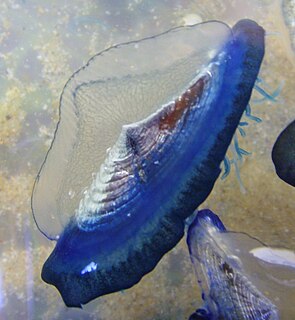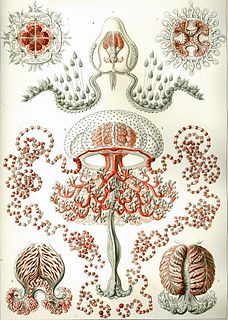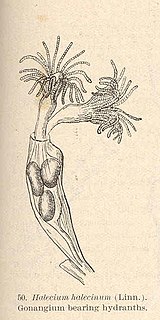
Hydrozoa are a taxonomic class of individually very small, predatory animals, some solitary and some colonial, most living in salt water. The colonies of the colonial species can be large, and in some cases the specialized individual animals cannot survive outside the colony. A few genera within this class live in fresh water. Hydrozoans are related to jellyfish and corals and belong to the phylum Cnidaria.

Velella is a monospecific genus of hydrozoa in the Porpitidae family. Its only known species is Velella velella, a cosmopolitan free-floating hydrozoan that lives on the surface of the open ocean. It is commonly known by the names sea raft, by-the-wind sailor, purple sail, little sail, or simply Velella.

Turritopsis dohrnii, also known as the immortal jellyfish, is a species of small, biologically immortal jellyfish found worldwide in temperate to tropic waters. It is one of the few known cases of animals capable of reverting completely to a sexually immature, colonial stage after having reached sexual maturity as a solitary individual. Others include the jellyfish Laodicea undulata and species of the genus Aurelia.

Anthoathecata, or the athecate hydroids, are an order of hydrozoans belonging to the phylum Cnidaria. A profusion of alternate scientific names exists for this long-known, heavily discussed, and spectacular group. It has also been called Gymnoblastea and, Anthomedusa,Athecata, Hydromedusa, and Stylasterina. There are about 1,200 species worldwide.

Leptothecata, or thecate hydroids, are an order of hydrozoans in the phylum Cnidaria. Their closest living relatives are the athecate hydroids which are similar enough to have always been considered closely related, and the very apomorphic Siphonophora which were placed outside the "Hydroida". Given that there are no firm rules for synonymy for high-ranked taxa, alternative names like Leptomedusa, Thecaphora or Thecata, with or without the ending emended to "-ae", are also often used for Leptothecata.

Plumularioidea is a superfamily of hydrozoans in the order Leptothecata.

Cladonematidae is a small family of anthomedusan hydrozoans. They have stolonal hydroid colonies, and their medusae are benthic and can crawl across the sediment; in many species they have lost the ability to swim however.
Lovenellidae is a family of hydrozoans. Their hydroids live together in upright stolonal or sympodial colonies, and their gonophores are pedunculate free-roaming medusae. The relationships of this fairly small but distinctive radiation to other members of the order Leptothecata are not well understood at present.

A gonophore is a reproductive organ in Hydrozoa that produces gametes. It is a sporosac, a medusa or any intermediate stage.
Bougainvilliidae is a family of marine hydroids in the class Hydrozoa. Members of the family are found worldwide. There are sixteen accepted genera and about ninety-three species.

Bougainvillia muscus is a marine invertebrate, a species of hydroid in the suborder Anthomedusae.

Aequoreidae is a family of hydrozoans. There are approximately 30 known species found in temperate and tropical marine coastal environments. Aequoreids include Aequorea victoria, the organism from which the green fluorescent protein gene was isolated.

Pandeidae is a family of hydroids in the class Hydrozoa. Like other jellyfish there is usually a mature medusa form which is pelagic and reproduces sexually and a hydroid or polyp form which is often benthic and reproduces asexually by budding.
Bougainvillia aberrans is a marine invertebrate, a species of hydroid in the suborder Anthomedusae. It was first described by Dale Calder in 1993. They have four radical clusters of marginal tentacles. Bougainvillia aberrans is found in Bermuda in the western North Atlantic Ocean.

Eudendrium ramosum, sometimes known as the tree hydroid, is a marine species of cnidaria, a hydroid (Hydrozoa) in the family Eudendriidae of the order Anthoathecata.

Obelia longissima is a colonial species of hydrozoan in the order Leptomedusae. Its hydroid form grows as feathery stems resembling seaweed from a basal stolon. It is found in many temperate and cold seas world-wide but is absent from the tropics.

Solanderia is the sole genus of hydrozoans in the monotypic family Solanderiidae. They are commonly known as tree hydroids or sea fan hydroids.

Pennaria disticha, also known as the Christmas tree hydroid, is a species of athecate hydroid in the family Pennariidae. Colonies are common in the Mediterranean Sea growing on rocks close to the surface. This species has been used in research into prey capture.

Sertularella polyzonias is a branching colonial hydroid in the family Sertulariidae.

Halecium halecinum, commonly known as the herring-bone hydroid, is a species of hydrozoan in the family Haleciidae. It is native to the eastern Atlantic Ocean, the western Atlantic Ocean and the eastern Pacific Ocean.

















